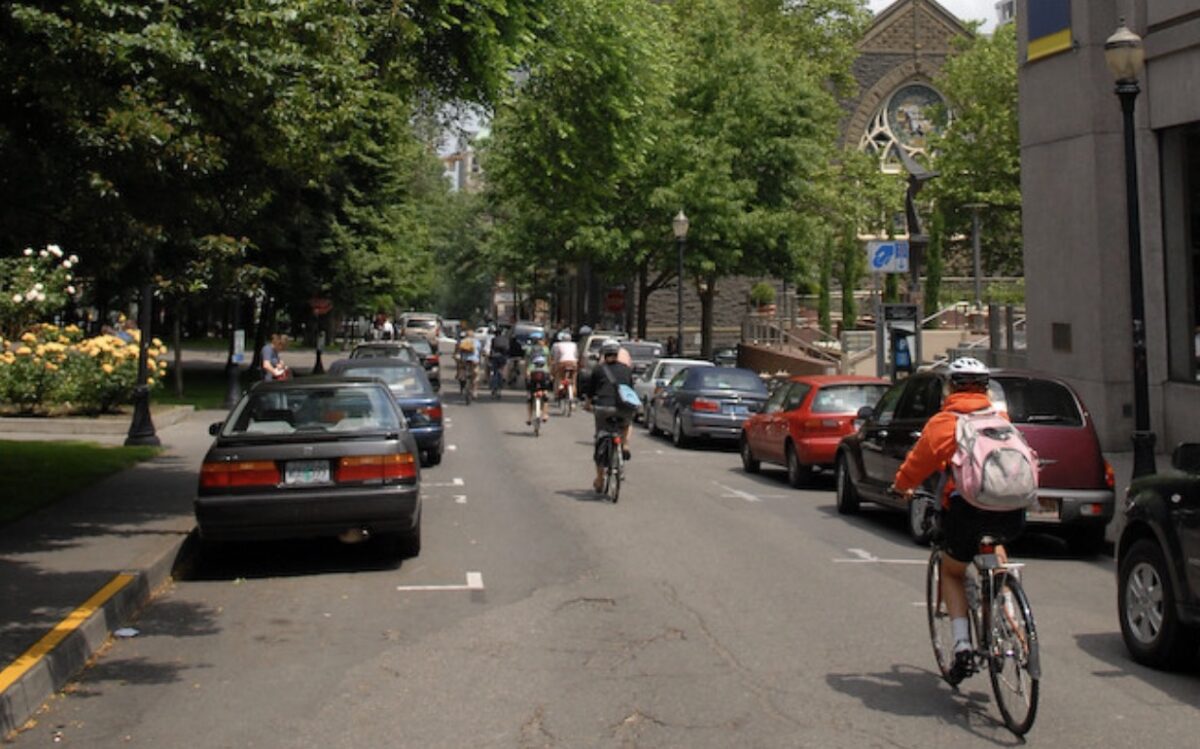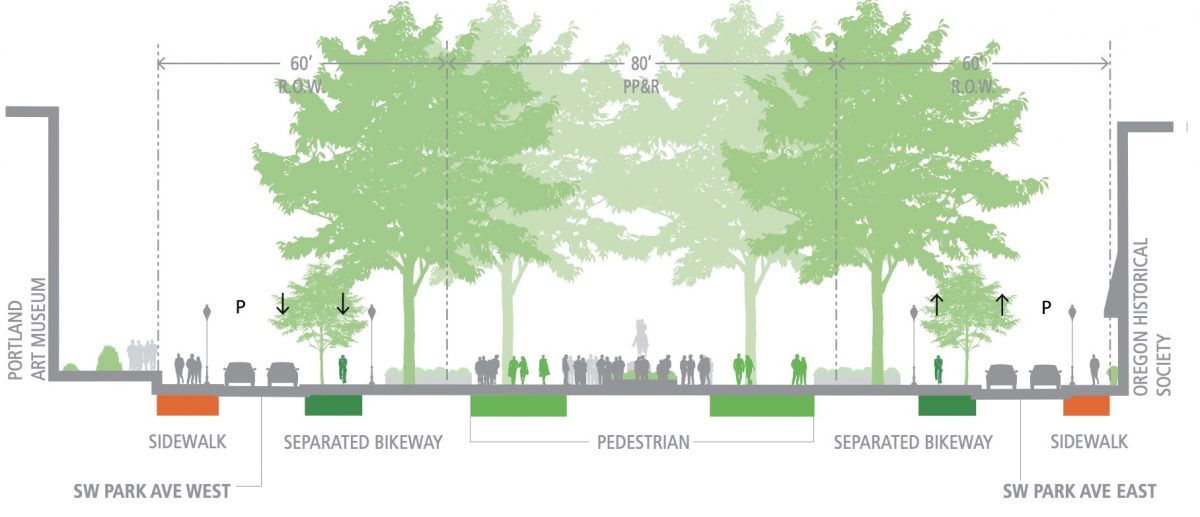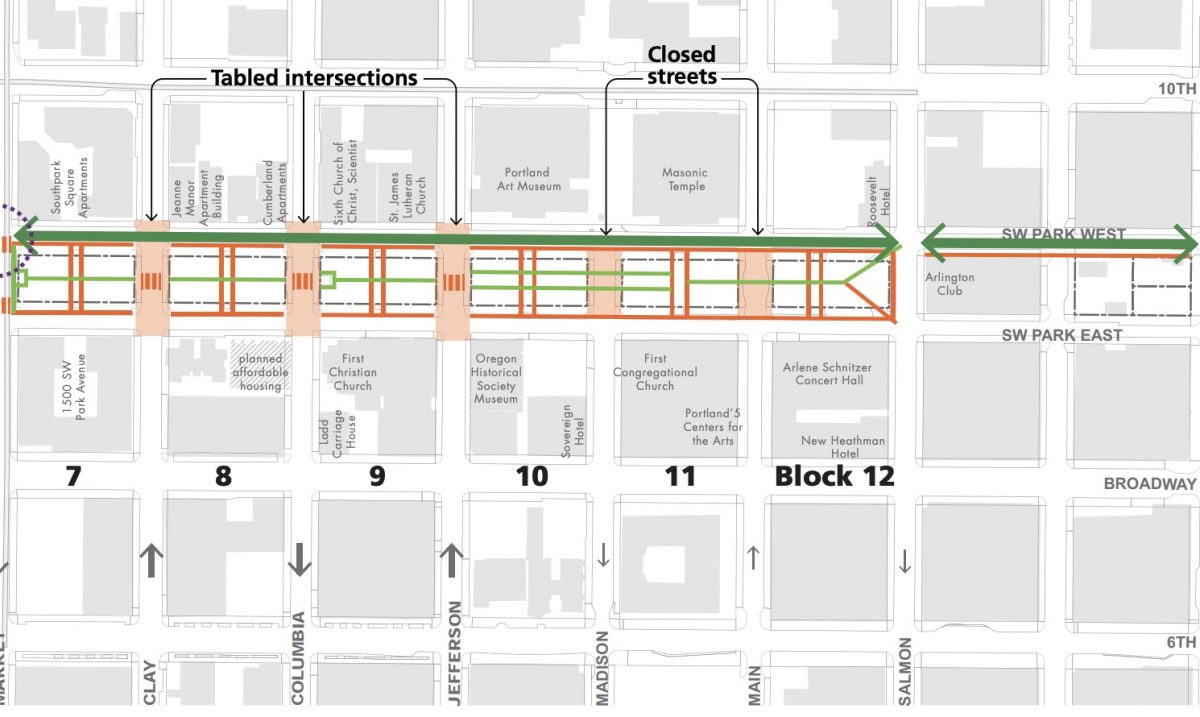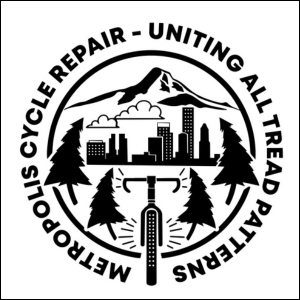
(Photo © J. Maus/BikePortland)
“The preference is to have the dedicated bike lanes… on Broadway. Cyclists will actually be safer there with fewer pedestrian encounters.”
— Wendy Rahm, Downtown Neighborhood Association
The City of Portland is working on a master plan for the South Park Blocks and there’s a key element that doesn’t sit well with the Downtown Neighborhood Association: bike lanes.
The South Park Blocks are considered a shoe-in for the alignment of the forthcoming Green Loop, which the Bureau of Planning and Sustainability describes as, “a signature 6-mile linear park and active transportation path.” Design concepts for the South Parks Master Plan released last month offered the most detailed look yet at how the Green Loop would travel through the 12-block SW Park Avenue couplet. All the concepts under consideration include a mix of dedicated bikeways and shared-use paths.
The Downtown Neighborhood Association (DNA) thinks that’s a bad idea.


Advertisement
In a November 27th letter (PDF) signed by DNA Chair Walter Weyler and DNA Land Use Transportation Committee Chair Wendy Rahm, they argue that bicycle riders in the Park Blocks will pose safety hazards to people walking. The DNA wants the bike route to be focused one block over on SW Broadway.
Here’s a list of reasons the DNA gives for their opposition to the bikeways:
– Many school children cross Park Avenue on field trips every week. The DNA doesn’t give a specific reason why this is a problem, but it’s clear they believe bicycle riders pose an imminent safety hazard to these children.
– Bicycle users have other places to ride, but this is the only park for many people in the neighborhood:
“There is no alternative green space for this population [of West End residents], but there are plenty of other streets where bicycles can ride.”
– Bicycle users and busy walking zones (like those around streetcar stops) are incompatible. By contrast, the DNA believes cars and the people who drive them are just fine:
“Because current on-street parking reduces the single car lane to one narrow lane, cars go very slowly; parked cars on both sides of the street currently act to protect pedestrians on sidewalks. Pedestrians can easily and safely cross a narrow, single lane of slow-moving cars.”
Advertisement
More bicycle riders would mean more scofflaws:
“Auto drivers are licensed and cars registered, so tracking and enforcement of violations is possible. Because cyclists are neither trained nor licensed and because bicycles are not registered so not traceable, it is not possible to report violations. This lack of enforcement likely contributes to the many violations and “encounters” nearby residents witness/experience already today, without an increase of more cyclists the Green Loop would bring.”
A dedicated bikeway is incompatible with the Farmers Market:
“Vendors also need temporary parking to be able to deliver their produce and set up their temporary stands in Shemanski Park which would be complicated by a bike lane in place of parking spaces. To reduce conflicts between distracted shoppers and cyclists, at least on market-day, closing down these bike lanes would also seem advisable.”
People who attend churches along the South Park Blocks don’t ride bikes and they need a place to park their cars:
“Hundreds of people attend the churches that line the South Park Blocks certainly on Sundays, which is also a popular day for cycling. Worshippers come by foot, by public transportation or car from the suburbs (needing parking), but they all end up on the sidewalks and the park blocks as pedestrians… We suggest it will be important to contact all these churches directly to hear their assessment of the impact of an increase in bicycles and a loss of parking.”
Only a small percentage of people currently bike to the South Park Blocks, so we don’t need to improve conditions for them:
“When asked in the Parks survey how people usually travel to the South Park Blocks, the overwhelming majority come by foot (nearly 90%). Cyclists weren’t even close (less than 10%).”
Advertisement
To minimize what they see as the negative impacts of dedicated bike lanes, the DNA offers several counter-proposals. They want the Parks Blocks to be a “pedestrian priority area” and to move the Green Loop to SW Broadway. If Broadway isn’t feasible, they want bicycle riders to dismount and walk in the busiest blocks and they’re asking PBOT to install stop signs for bicycle lanes only. “Cars already stop at any sign of pedestrians midblock or at crosswalks, but cyclists do not,” the letter reads. If dedicated bike lanes are installed, they should come with, “Design features that effectively force cyclists to slow down.” And to improve compliance with traffic laws, the DNA wants the city to create a “cyclist licensing and bicycle registration program.”
Asked today for an update and clarification on their stance, DNA’s Wendy Rahm said the letter was approved by the DNA Board and sent to Mayor Ted Wheeler, Transportation Commissioner Chloe Eudaly, and Parks Commissioner Nick Fish. Rahm added that no one in attendance at the neighborhood’s Land Use Transportation Committee meeting this morning supported dedicated bike lanes along the Park Blocks. “The preference is to have the dedicated bike lanes run where the planned commuter lane is to be, on Broadway,” Rahm shared in an email. “Cyclists will actually be safer there with fewer pedestrian encounters. That is not to say bikes cannot use the streets along the Park Blocks, just that there would not be dedicated lanes there so they would need to follow all traffic laws.”
Rahm added that in her mind, the DNA is taking a “pro bike position” and that their concerns are for, “both pedestrian and cyclist’s safety and convenience.”
If you’d like to learn more about the South Parks Master Plan and share your feedback about cycling in the Park Blocks, check out the project website and take the visioning survey. Comments will be accepted until 5:00 pm on December 30th.
— Jonathan Maus: (503) 706-8804, @jonathan_maus on Twitter and jonathan@bikeportland.org
— Get our headlines delivered to your inbox.
— Support this independent community media outlet with a one-time contribution or monthly subscription.



